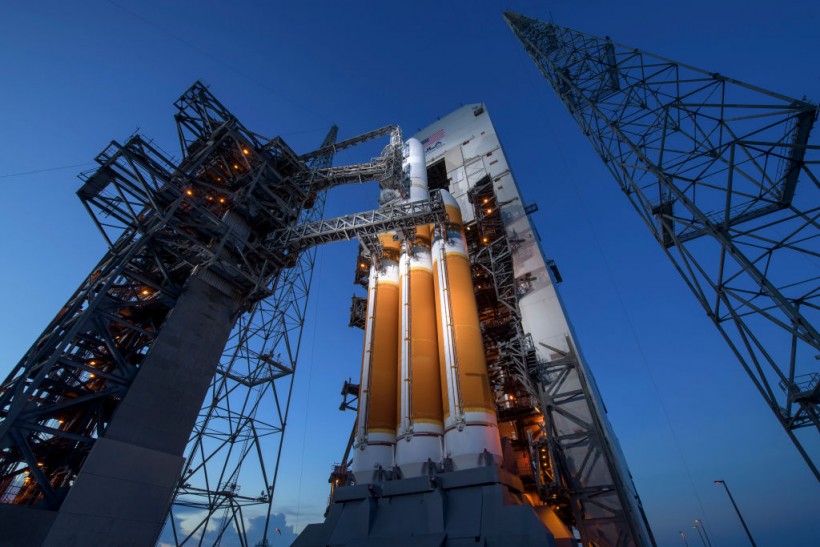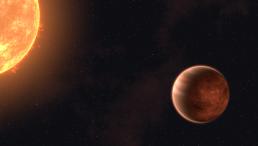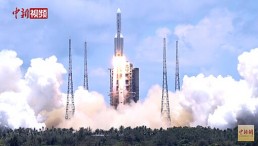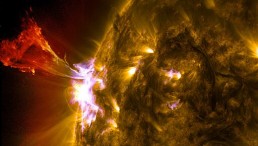The United Launch Alliance (ULA) scrubs its launch attempt for one of the largest members of its rocket fleet, the Delta IV Heavy. The rocket is set to carry a spy satellite for the National Reconnaissance Office on Thursday (NRO), August 27, at 2:21 AM EDT.
The canceled launch was supposed to take place from Space Launch Complex 37 at the Cape Canaveral Air Force Station. Under the mission codename NROL-44, the Delta IV Heavy flight marks the 12th mission that uses that same rocket model since it was first debuted in 2004. In an announcement on the ULA's twitter page, it said that launch director Lou Mangieri announced the postponement of the countdown operations for the NROL-44 mission. However, the statement noted the possibility of another attempt within 24 hours.

CAPE CANAVERAL, FL - AUGUST 11: In this handout provided by NASA, The Mobile Service Tower is rolled back to reveal the United Launch Alliance Delta IV Heavy rocket with the Parker Solar Probe onboard, Saturday, Aug. 11, 2018, Launch Complex 37 at Cape Canaveral Air Force Station in Florida.
Launch Director Lou Mangieri has announced that we will not continue with the #DeltaIVHeavy rocket countdown operations today for #NROL44. Another launch attempt will be possible in 24 hours. — ULA (@ulalaunch) August 27, 2020
On-ground teams scrubbed the mission, citing technical issues detected during the countdown. There was an issue with a heater installed in the Delta IV Heavy's nose cone, with the diagnostics later looking at a separate concern in the launch's ground-based pneumatics. Had the issues been resolved, the launch would have been moved up until 6:25 AM EDT, to commence launch. However, by 1:20 AM, ULA mission managers decided to scrub the mission to allow enough time for investigations and troubleshooting.
A Powerful Launch Craft
The Delta IV Heavy, an expendable heavy-lift launch craft, is the largest and most powerful rocket in the ULA fleet. Fueled by 465,000 gallons, or more than 1.76 million liters, of supercooled fuel that is a mix of liquid oxygen and liquid hydrogen, this rocket can generate more than two million pounds of thrust. It was the most powerful rocket before SpaceX launched the Falcon Heavy rocket.
RELATED: Upcoming SpaceX Starlink Satellite Launch to Set New Milestones
Moments before its launch countdown, it's 330-foot high supporting Mobile Service Tower (MST) will be detached from the rocket - itself standing at a height of 232 feet, with a width of 53 feet. The Delta IV Heavy is made up of three common core boosters (CBC), strapped together for the rocket's first stage. All CBC sections also employ hydrogen fuel.
In the second stage of the rocket, Delta IV Heavy uses a Delta Cryogenic Second Stage (DCSS) rocket. It contains a cylindrical liquid hydrogen tank separated from a liquid oxygen tank.
During lift-off, all three CBC cores operate at full thrust, reducing capacity down to 55% approximately 44 seconds after launch. After the first stage burns out at launch, the second stage will ignite and complete the flight to orbit.
In its 11-flight history, seven completed Delta IV Heavy missions carried payloads for the NRO. The upcoming flight becomes its 12th flight and the eights with an NRO payload.
The upcoming National Reconnaissance Office Launch 44 (NROL-44) also marks the first Delta IV mission since January 2019. The Delta IV Heavy is already scheduled to retire, but not before completing five missions contracted for the missile configuration up until 2024.
Carrying Spy Satellites
As with previous NRO payloads, the specific details about the spy satellite awaiting launch remain officially classified. According to the online portal NASA Spaceflight, the NRO launches satellites for a variety of roles. Some of these are requirements for optical and radar imaging of the Earth, tracking of ships in the ocean, and interception of radio signals often used in different communication media.
RELATED: California Wildfires Visible From Space, Astronaut Sends "Thoughts and Prayers"
It also narrows down the satellite class in the NROL-44, stating that two satellite designs require the largest rockets - such as the Delta IV Heavy - for launch: the Crystal optical imaging satellites, positioned in near-polar and sun-synchronous orbits, and the Orion large signals intelligence satellites, working in equatorial geostationary orbits.
Often, NRO payloads this site are intended to be installed on the carrier rockets in a vertical setup, instead of installing them horizontally.
According to ULA, the launch weather forecast for the launch remains "favorable with an 80% chance of acceptable conditions."
LAUNCH ALERT: The launch weather forecast for this evening's #DeltaIVHeavy countdown and overnight liftoff of #NROL44 at 2:12amEDT (0612 UTC) remains favorable with an 80 percent chance of acceptable conditions. Read more details on the forecast: https://t.co/GKgbdk3wMm pic.twitter.com/kO0e4gzLrl — ULA (@ulalaunch) August 26, 2020
Check out more news and information on Space on Science Times.













!['Cosmic Glitch' in Einstein's Theory of General Relativity Could Be Explained in This New Scientific Tweak [Study]](https://1721181113.rsc.cdn77.org/data/thumbs/full/53435/258/146/50/40/cosmic-glitch-in-einsteins-theory-of-general-relativity-could-be-explained-in-this-new-scientific-tweak-study.jpeg)
